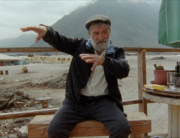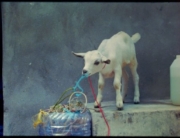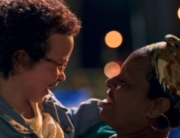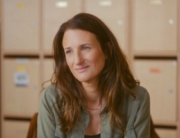
Talk about taking a risk: Israeli director/writer Ari Folman and his team have made what is reportedly the first Holocaust film for young audiences, roughly for ages 12 to early teens.
Ten years in the making, the project was initiated and shepherded by the Anne Frank Fonds, the copyright holder of The Diary of a Young Girl. Folman (Waltz with Bashir) imaginatively and purposefully depicts the Jewish teenager’s life while she was hiding from the Nazis for two years in a secret Amsterdam annex with her family and four others.
Departing from a straightforward biopic, Folman throws in a twist: the animated movie is told from the perspective of Kitty, Anne’s imaginary friend to whom she wrote diary entries from 1942–44. The filmmaker retells the story of Anne and her times through Kitty to underline the diary’s relevance. In his own way, he asks contemporary audiences: What would Anne Frank do today?
It opens “a year from now,” during a rainstorm. Lightning strikes Amsterdam’s Anne Frank House in the early morning hours—there’s already a line of tourists waiting to get in. (The wind, so strong, blows away the temporary shelter for a nearby family of refugees.) The bolt breaks through a skylight and strikes the vitrine containing the original diary manuscript. What looks like smoke is, in fact, black ink swirls, drifting up and coming together into the formation of a redheaded teenager, Kitty (voiced by Ruby Stokes), dressed in the schoolgirl fashion of the early ’40s—she also resembles Saoirse Ronan.
All alone in the museum, Kitty calls out for Anne and her family. She ends up in Anne’s room, where fan photos of Marlena Dietrich, Greta Garbo, and Clark Gable plaster the wall. Having the diary all to herself, she picks it up and begins reading the first entry: June 1942, Anne’s birthday. Among her presents, besides a puzzle and perfume, is the blank journal, given to her by her mother, Edith.
Although the pen-and-ink Kitty has been conjured by Anne’s imagination—with Veronica Lake’s hair and Ava Gardner’s lips—Kitty’s a blank slate, knowing nothing about Anne and what led the Franks to find refuge on the top floors in the building where father Otto Frank used to work, and how, almost day by day, the civil rights of Jews were taken away, leading the family to dodge deportation orders and go into hiding.
Invisible to all the visitors crowding the museum, Kitty naps and patiently waits for Anne during the day as she lies on her best friend’s bed. In the daylong crowd, she notices a young teen pickpocketing the well-heeled visitors. After museum hours and now all alone, Kitty ventures out of the building to file a missing person report.
Out on the present-day streets, she becomes visible to others, so long as she’s physically close to the actual diary, which she brings with her; she hasn’t finished reading all of it yet. Unbeknownst to her, Kitty has become public enemy number one, the main suspect in the theft of a national treasure, the diary. At the police station, an officer recognizes her from the police reports and before he apprehends her, Kitty skedaddles and returns to the Anne Frank House, which perhaps ironically becomes a safehouse once again. There, when she picks up the diary, she’s back in the ’40s and often having a teenage tête-à-tête with Anne (Emily Carey).
During her investigation of Anne’s whereabouts, Kitty sneaks into the Anne Frank Theater (where the kids in the audience are glued to their smartphones) and watches Anne’s life in the annex portrayed on the stage. Based on the declamatory dialogue, it’s a sendup of 1955’s Anne Frank: Diary of a Young Girl, by Frances Goodrich and Albert Hackett, which was very much a product of its times. The play adds to Kitty’s confusion; she realizes no one is discussing at any length what happened to the real-life Anne after she was captured.
Kitty teams up with her new friend, the juvenile thief she had seen earlier. In the credits, he goes by the name of Kitty’s Peter (Ralph Prosser), not to be confused with Anne’s Peter (Sebastian Croft), who lived on the annex’s top floor. On the lam, they elude the police, and their curiosity leads them on a train trip to the Nazi transit camp Westerbork, where the Franks were deported to. From there, Kitty and her sidekick follow Anne’s trail to Bergen-Belsen.
Kitty and Peter’s daring-do and close calls with the cops lead to extended chase sequences that turn their exploits into adventures, but they also take the focus away from Kitty’s discoveries. Even younger viewers might want the film to skip to the chase, so to speak. Peter winds up taking Kitty to a squatters’ camp, a home for refugees, all of whom are under the threat of deportation. Though it’s only one part of the narrative, viewers may look askance as Kitty becomes the spokesperson for the downtrodden, many of them children escaping from war zones, such as in Mali.
Animation director Yoni Goodman’s handcrafted visuals contrast the dark gray skies of contemporary Amsterdam to the bold colors of Anne’s imagination, particularly her vision of the war’s end, where the pantheon of Greek deities and warriors charge on horseback—with Gable on a white stallion leading the way—to confront the black-cloaked Nazi goons, all with skeletal faces. Additionally, the movements of Anne and the others trapped in the annex have a fluidity that looks like they could have been rotoscoped, though they weren’t.
According to the Anne Frank Fonds, the movie “is also intended for adults who read the Diary when they were growing up and who can now experience it in a new form.” Like Kitty, viewers may feel like they are encountering Anne for the first time because of the movie’s innovative approach that is accessible to young audiences without watering down or sentimentalizing the last seven months of Anne’s life, and without resorting to graphic realism. No matter how familiar you are with the history of Anne Frank and her family, you are bound to be moved.
Where Is Anne Frank had its North American premiere at this year’s Toronto International Film Festival.






Leave A Comment